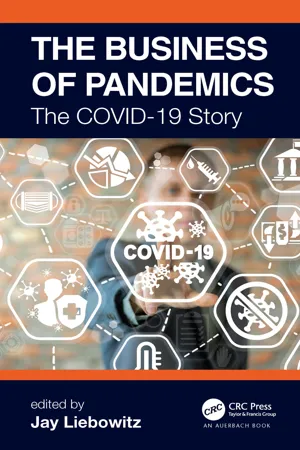
- 216 pages
- English
- ePUB (mobile friendly)
- Available on iOS & Android
About This Book
Nations and businesses across the globe have been working through the difficulties of dealing with the COVID-19 pandemic. Industry, academia, NGOs, and governments have been "feverishly" searching for ways to address this deadly virus, which may continue to spread for at least the next year and perhaps beyond (in terms of a resurgence and different strains).
From a business standpoint, there have been dramatic effects on logistics and supply chains, economic downfalls, bailouts of major industries and small businesses, and far-reaching calamities from around the world. Even though the COVID-19 story is still in its making, this book focuses on the business of pandemics as applied to COVID-19. The book brings together a global panel of experts across industries and NGOs to help guide business executives and managers through the complex array of issues affecting business in the time of a pandemic.
Offering solutions to the business of pandemics as applied to COVID-19, the book is written for organizational decision makers and leaders, as well as those involved in crisis management, public health, and related fields. Its chapters focus on key areas that relate to the business of pandemics, including
-
- Lessons learned to date
-
- Big data and simulation
-
- Logistics and supply-chain management challenges
-
- Conducting global business virtually
-
- Global economic impact
-
- Media and risk communication
-
- IT infrastructure and networking
-
- Social impact
-
- Online learning and educational innovations
-
- The new work-from-home environment
-
- Re-opening markets and businesses
-
- Crisis decision making using analytics and intuition
With chapters authored by experts from leading organizations, including the World Health Organization, the RAND Corporation, and various universities throughout the world, The Business of Pandemics: The COVID-19 Story provides high-level guidance and insight for business leaders who must deal with the complexities and challenges presented by this unprecedented crisis.
Frequently asked questions
Information
Chapter 1
Business and Management Lessons Learned from COVID-19
Abstract
1.1 Management and Crisis
1.2 The Life Cycle of a Crisis

1.2.1 Prevention
Map the Existing Value Chain
Identify and Assess Possible Disruptions
Table of contents
- Cover
- Half Title
- Title Page
- Copyright Page
- Dedication
- Table of Contents
- List of Illustrations
- About the Editor
- Contributing Authors
- Foreword The Business of Pandemics—Or Building It While We Fly It
- Foreword A Public Health and Knowledge Management Perspective
- Preface
- Chapter 1 Business and Management Lessons Learned from COVID-19
- Chapter 2 Using Data, Computer Models, and Simulations to Predict the Spread of Diseases Like COVID-19
- Chapter 3 Conducting Global Business Virtually During a Crisis
- Chapter 4 Global Economic Impact Resulting from COVID-19
- Chapter 5 COVID-19 and the Seven Pillars of Effective Risk and Crisis Communication
- Chapter 6 Flying into a Geopolitical Storm
- Chapter 7 Growing Organizational Capacities for Increased Online Learning, Working, and Health
- Chapter 8 The Social Impact(s) of COVID-19
- Chapter 9 COVID-19 and the Education Innovation Gap
- Chapter 10 The Global Remote Work Experiment and the Future of Work
- Chapter 11 Re-Opening Markets and Businesses That Have Been Shut or Severely Curtailed
- Chapter 12 Supporting Decision Making During a Pandemic: Influence of Stress, Analytics, Experts, and Decision Aids
- Index